Introduction
In a world where wellness and productivity go hand in hand, full body workouts are emerging as a powerful solution for busy professionals seeking to enhance their health without sacrificing time. By engaging multiple muscle groups simultaneously, compound exercises like squats and deadlifts not only build strength and endurance but also mirror the movements of daily life, promoting functional fitness.
As organizations increasingly prioritize employee well-being, understanding the benefits of these dynamic workouts becomes essential. This article delves into the effectiveness of full body dumbbell routines, dispelling myths, and offering actionable strategies for incorporating them into everyday schedules.
By embracing these practices, HR Benefits Managers can champion a culture of health that empowers their teams to thrive both inside and outside the workplace.
Understanding Compound Exercises: The Foundation of Full Body Workouts
A full body dumbbell compound workout consists of dynamic exercises that involve various muscle groups and joints simultaneously, making them an outstanding option for improving power and endurance. Movements such as squats, deadlifts, and bench presses not only enhance workout efficiency by focusing on different groups simultaneously but also replicate daily activities, thereby improving functional ability. Recent studies underscore the cardiovascular benefits of squats, revealing that resistance training can enhance heart function, lower resting heart rates, and reduce blood pressure, with menopausal women showing significant improvement in cholesterol and triglyceride levels after just 26 weeks of training.
Weight training is typically applied with an intensity of 40–60% of 1 RM and involves 10–15 repetitions, providing a clear framework for effective training. Alongside a full body dumbbell compound workout, other advantageous resistance exercises such as:
- Push-ups
- Bench presses
- Deadlifting
- Pull-ups
contribute to overall health and fitness. As Assal Arian, a renowned Peloton instructor, aptly states,
All in all, compound lifts give you the best [results] for strength, muscle size, endurance, fat loss, athleticism, and aesthetics.
This insight reflects current trends in comprehensive exercise routines that prioritize a full body dumbbell compound workout. Moreover, to avoid injury while performing these exercises, it is advised to work with a trainer, especially for beginners, and to adhere to proper technique. By comprehensively understanding the mechanics and benefits of these exercises, HR Benefits Managers can effectively promote them within their wellness programs, ultimately fostering improved performance and health among their teams.
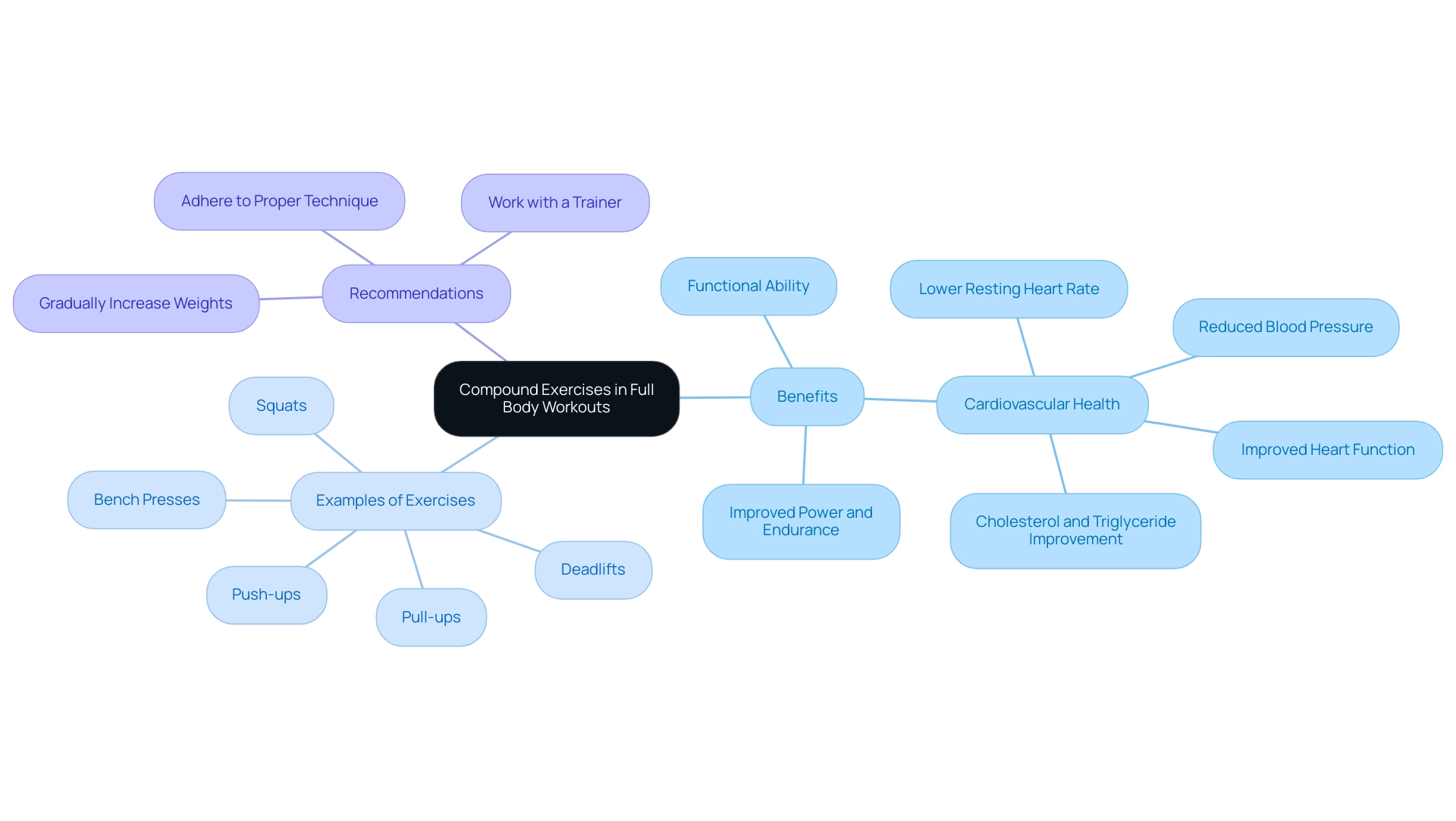
The Benefits of Full Body Dumbbell Workouts: Efficiency and Effectiveness
A full body dumbbell compound workout provides a variety of advantages that meet the needs of busy professionals seeking both efficiency and effectiveness in their fitness routines. Engaging various body groups in a single session not only maximizes calorie burn but also fosters improved cardiovascular health. This holistic approach is particularly advantageous for individuals with constrained schedules, allowing them to achieve substantial results without the need for extensive time commitments.
Significantly, split routines necessitate additional training days and exercise volume on specific areas, rendering full-body sessions a more effective option. Recent studies suggest that frequent participation in a full body dumbbell compound workout can lead to slightly improved fat loss, underscoring the importance of pairing these sessions with proper dietary choices. Furthermore, utilizing dumbbells provides a greater range of motion and versatility, which significantly enhances muscle activation.
As noted by fitness experts,
If none of the above apply to you, you're likely better off sticking to full-body exercises focused on functional movement, longevity, and overall health.
This makes comprehensive exercise sessions, such as a full body dumbbell compound workout, an ideal and inspiring solution for HR Benefits Managers striving to enhance their team's well-being and fitness objectives. The case study titled 'Advantages of Full-Body Workouts' illustrates that these routines simplify training while ensuring comprehensive muscle development and balance, empowering individuals to take control of their health and fitness journeys.
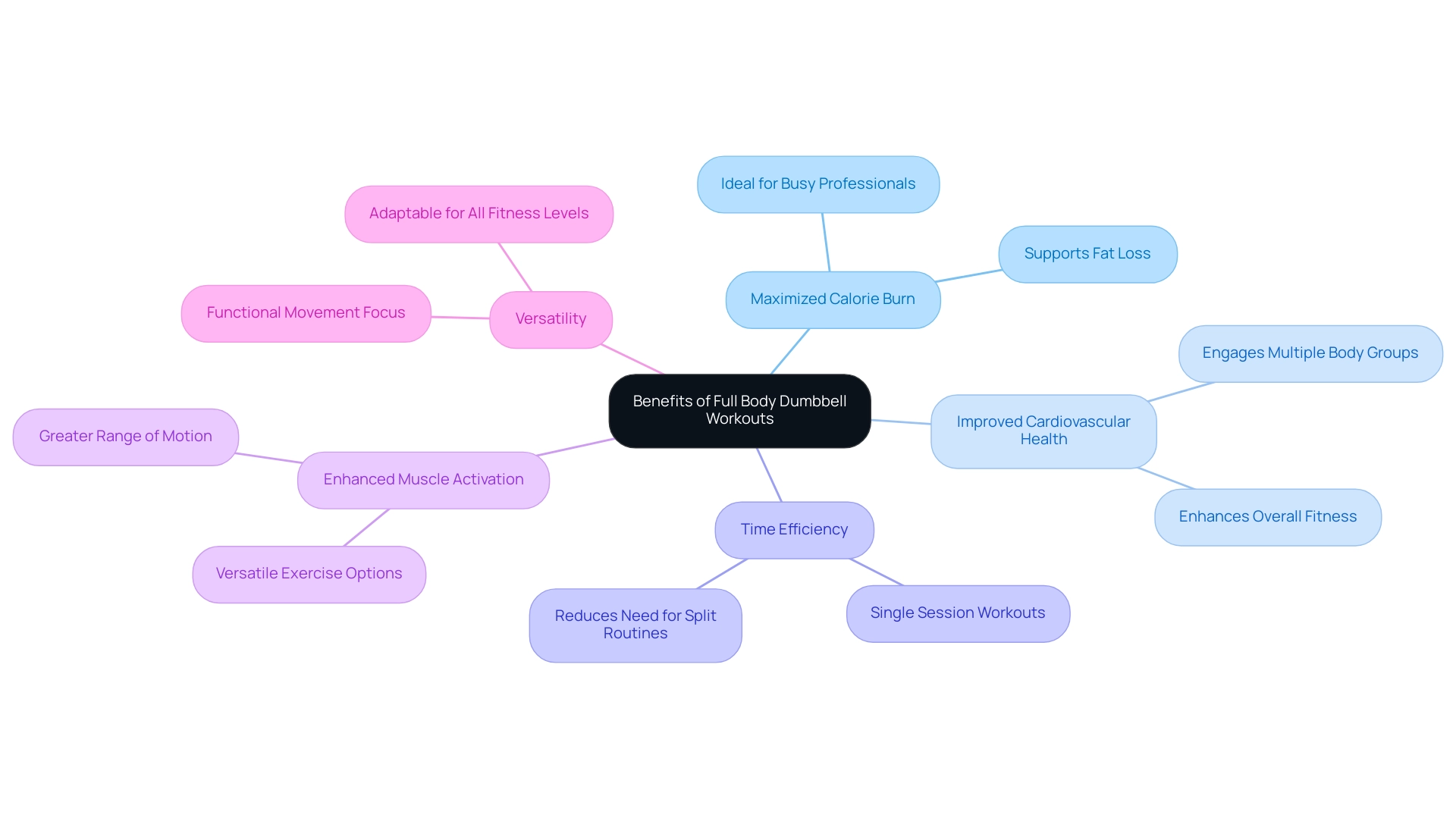
Key Compound Dumbbell Exercises for a Full Body Workout
Incorporating key compound dumbbell exercises is essential for a well-rounded full body dumbbell compound workout. Here’s a closer look at some of the most effective movements:
- Dumbbell Squats: These not only target the legs and glutes but also engage the core, promoting stability and power throughout. Proper execution is crucial, as a wider grip can increase the risk of pectoralis tears and shoulder instability, with studies indicating that improper form can lead to a 30% higher risk of injury.
- Dumbbell Deadlifts: This powerful exercise strengthens the back, hamstrings, and glutes, while also enhancing posture. Utilizing proper form ensures maximum muscle activation, which can be as high as 80% for the targeted muscle groups, and minimizes the risk of injury.
- Dumbbell Bench Press: An essential upper body movement, this exercise effectively works the chest, shoulders, and triceps, contributing to improved upper body power and overall functionality.
- Dumbbell Rows: Perfect for building back power, dumbbell rows also aid in enhancing posture and balance, making them a staple in any training regimen.
- Dumbbell Lunges: Beyond strengthening the legs, lunges improve balance and coordination, vital components for overall fitness.
Incorporating a full body dumbbell compound workout into your routine can lead to balanced muscle development and greater functional fitness, promoting a healthier lifestyle for you and your team. As fitness coach Dave Brummert states,
Most weight coaches will build a program around increasing all three of these factors, but when it comes to deciding between squats and deadlifts to improve all of these, we need some more details.
This highlights the importance of understanding the nuances of these exercises.
By prioritizing these movements, you not only enhance personal power but also set an inspiring example for your colleagues, especially as we approach World Heart Day on September 29th. This day is dedicated to raising awareness about heart health and promoting prevention strategies, such as maintaining a regular strength training regimen that can significantly benefit cardiovascular health.
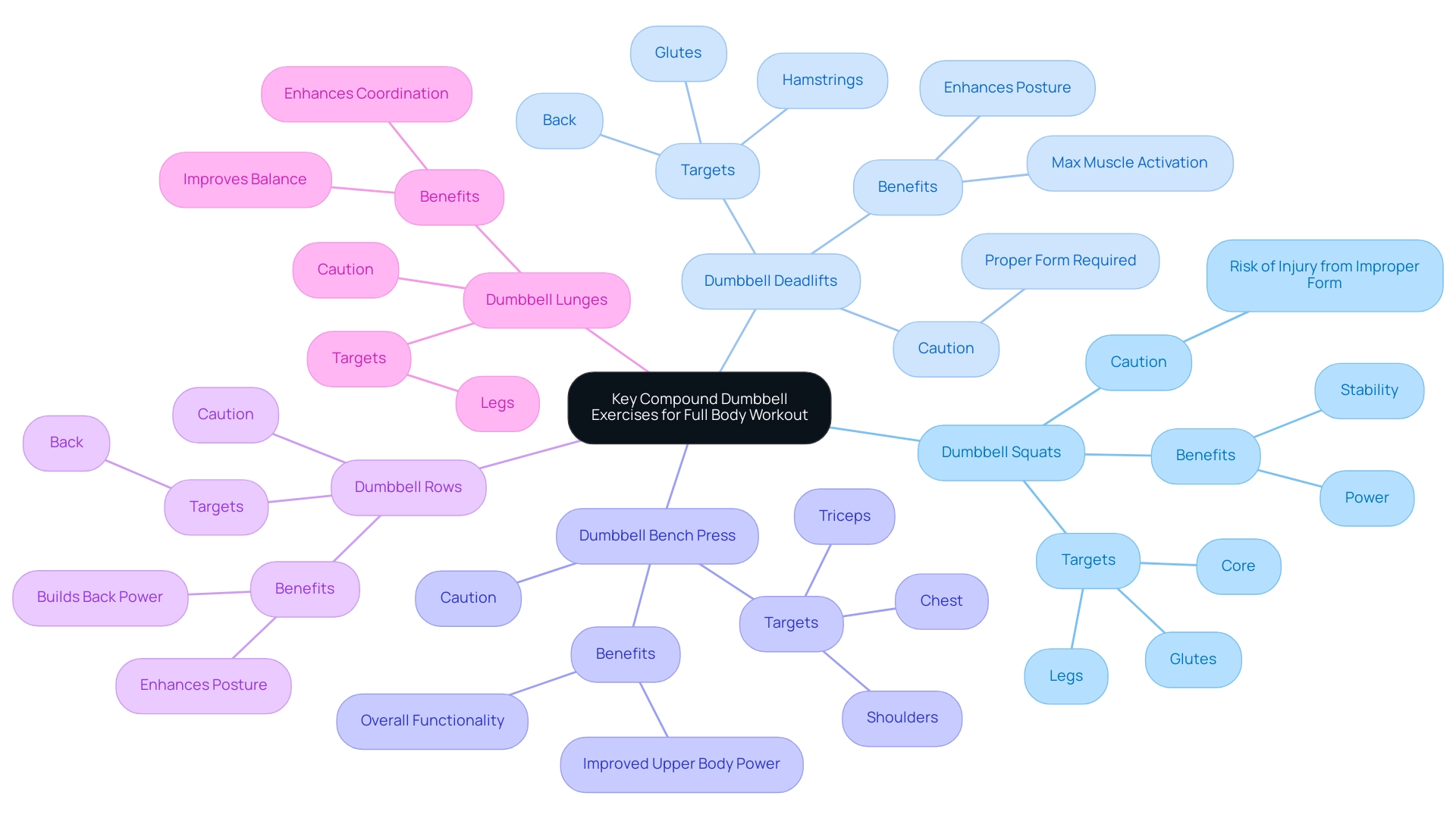
Full Body vs. Split Workouts: Debunking Myths and Misconceptions
Many myths surround the discussion between full training and split sessions, often creating confusion among fitness enthusiasts. A common misunderstanding is that complete exercises are lesser than split routines for strength development. However, recent studies reveal that engaging in a full body dumbbell compound workout can be just as effective, particularly for beginners and those managing tight schedules.
Research indicates that tissue thickness in participants increased significantly, with the Split Workout Routine showing a 2.3 mm increase (12.1%; p=0.001) and the Full-Body Workout Routine demonstrating a 2.1 mm increase (10.5%; p=0.001). This shows that complete routines promote similar engagement of tissues. Another myth is the belief that a full body dumbbell compound workout leads to overtraining.
When designed thoughtfully, a full body dumbbell compound workout allows for sufficient recovery while still maximizing stimulation of the body. By understanding these dynamics, individuals can confidently choose an approach aligned with their fitness goals and lifestyle. As noted by Zaroni et al., "Compararam os efeitos de regimes de Rotina Distribuída e Rotina de Corpo Inteiro sobre a adaptação neuromuscular em homens bem treinados ao longo de oito semanas de treinamento," highlighting the importance of customizing exercise plans to individual needs.
Furthermore, a case study named "Efficacy of Split-Body vs Full-Body Resistance Training" discovered no notable differences between the two training approaches regarding maximal strength, body mass, or explosive strength, further supporting that both training methods provide similar advantages. This evidence empowers participants to thrive in their fitness journeys.
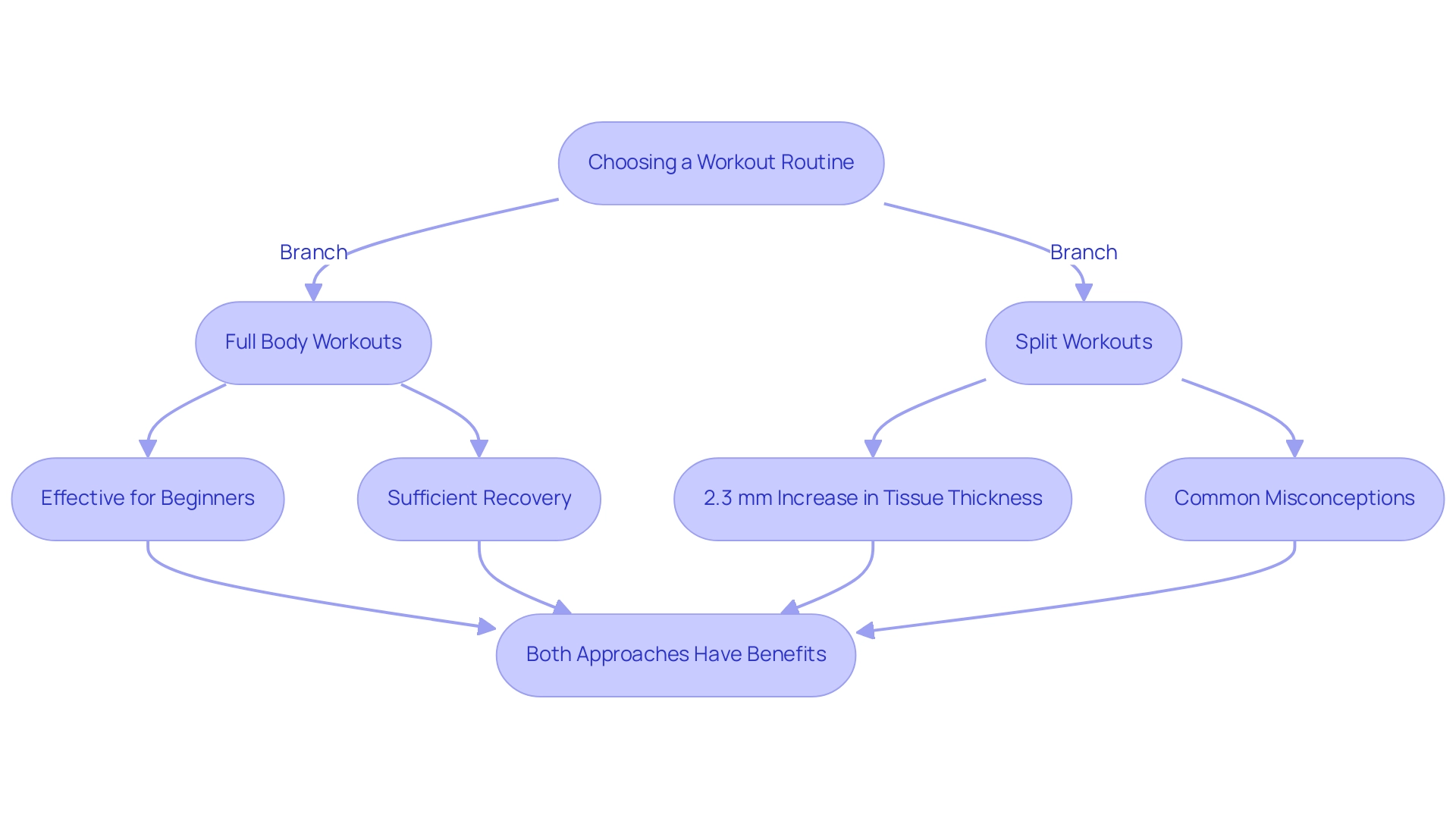
Incorporating Full Body Dumbbell Workouts into Your Routine: Tips and Strategies
To seamlessly incorporate a full body dumbbell compound workout into your routine and inspire a culture of health within your team, consider these empowering strategies:
-
Schedule Regular Sessions: Commit to at least two to three sessions per week. Consistency is key to fostering engagement and making fitness a priority.
As noted by Grant Ralston, there is very little experimental evidence of quality or consistency related to resistance training frequency, highlighting the need for a structured approach.
-
Start with a Balanced Approach: Implement a diverse mix of exercises that effectively target all major muscle groups, ensuring a comprehensive fitness experience.
Research indicates that resistance training has a mean effect size of 0.88 for low frequency and 0.77 for high frequency, underscoring its effectiveness.
-
Progress Incrementally: As your power grows, elevate the weights and intensity of your exercises.
This gradual progression helps prevent plateaus and keeps motivation high.
-
Listen to Yourself: Pay attention to how your physique reacts to various exercises.
Adjust your routine as needed to prioritize safety and prevent injury, which is crucial for long-term success.
-
Set Realistic Goals: Establish clear, achievable fitness goals to maintain motivation and track progress.
This clarity not only boosts individual morale but also encourages a supportive environment.
Additionally, consider partnering with Foresight Health Coaching to enhance your corporate wellness initiatives. By investing in this partnership, you can provide your team with access to a transformative health coaching app, which includes a free 7-day trial to support their wellness goals.
This trial allows your team to experience the benefits of the app firsthand, making it easier to commit to long-term wellness strategies.
Statistics support the effectiveness of resistance training, with studies showing it can decrease nursing home admissions by 84% among older adults who have undergone surgical repairs for osteoporotic hip fractures. Moreover, a case study named 'Strength Training for Weight Loss' showed that an 18-month program integrating strength training with diet resulted in a 19% reduction in fat mass while maintaining lean muscle mass, emphasizing the advantages of a full body dumbbell compound workout.
By adopting these approaches and exploring partnership opportunities, including how to contact Foresight Health Coaching, you can inspire your team to embrace a full body dumbbell compound workout, leading to improved health and enhanced performance in the workplace.
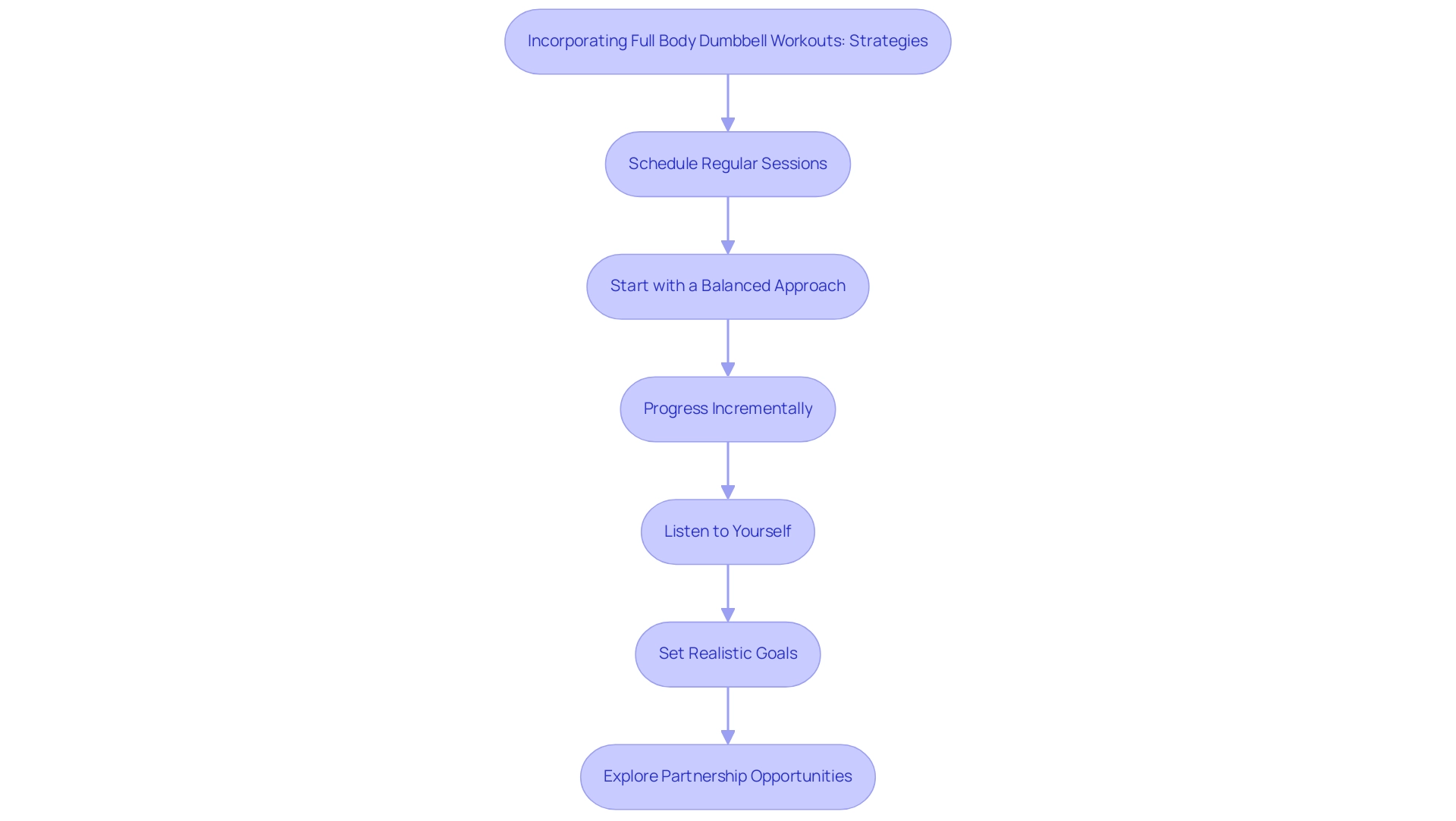
Conclusion
Incorporating full body workouts into a busy professional's routine presents a viable solution for enhancing overall health and productivity. By focusing on compound exercises, such as squats and deadlifts, individuals can engage multiple muscle groups simultaneously, leading to improved strength, endurance, and functional fitness. This approach not only maximizes workout efficiency but also aligns with the movements of daily life, making it highly practical for those with tight schedules.
The benefits of full body dumbbell workouts extend beyond mere convenience; they promote cardiovascular health and facilitate significant fat loss when paired with proper nutrition. As research indicates, these routines can yield comparable muscle growth and strength gains to traditional split workouts, dispelling common myths that full body routines are less effective. With the right structure and commitment, individuals can achieve substantial results, thus fostering a culture of health within their organizations.
By prioritizing these dynamic workouts, HR Benefits Managers can encourage their teams to adopt healthier lifestyles, ultimately enhancing workplace well-being. Embracing full body dumbbell routines not only empowers employees to take control of their fitness journeys but also contributes to a thriving, health-conscious workplace environment. Now is the time to inspire action and champion wellness initiatives that lead to lasting benefits for both individuals and organizations alike.
Frequently Asked Questions
What is a full body dumbbell compound workout?
A full body dumbbell compound workout consists of dynamic exercises that engage various muscle groups and joints simultaneously, improving power and endurance. Examples include squats, deadlifts, and bench presses.
What are the benefits of performing compound exercises?
Compound exercises enhance workout efficiency by targeting multiple muscle groups at once, replicate daily activities to improve functional ability, and provide cardiovascular benefits such as improved heart function, lower resting heart rates, and reduced blood pressure.
What is the recommended intensity and repetition range for weight training?
Weight training is typically performed at an intensity of 40–60% of one-repetition maximum (1 RM) with 10–15 repetitions for effective training.
What other resistance exercises complement a full body dumbbell compound workout?
Other advantageous resistance exercises include push-ups, bench presses, deadlifting, and pull-ups, which contribute to overall health and fitness.
How can beginners avoid injury while performing compound exercises?
Beginners are advised to work with a trainer and adhere to proper technique to avoid injury while performing compound exercises.
Why is a full body dumbbell compound workout suitable for busy professionals?
This workout maximizes calorie burn and fosters improved cardiovascular health within a single session, making it ideal for individuals with constrained schedules who seek substantial results without extensive time commitments.
How do full body workouts compare to split routines?
Full body workouts are more effective than split routines, as they do not require additional training days or exercise volume focused on specific areas.
What role does proper diet play in conjunction with full body dumbbell workouts?
Pairing full body dumbbell workouts with proper dietary choices is important for achieving improved fat loss and overall fitness results.
What advantages do dumbbells offer in workouts?
Dumbbells provide a greater range of motion and versatility, significantly enhancing muscle activation during exercises.
How can HR Benefits Managers promote full body dumbbell workouts within wellness programs?
By understanding the mechanics and benefits of these exercises, HR Benefits Managers can effectively promote them to foster improved performance and health among their teams.

